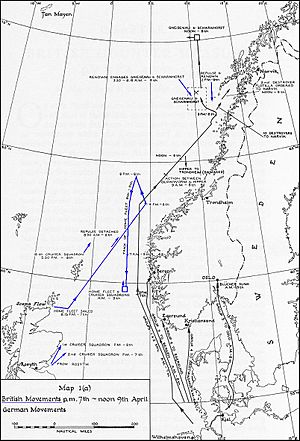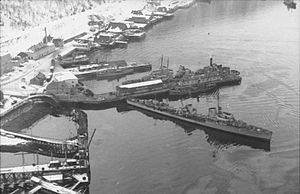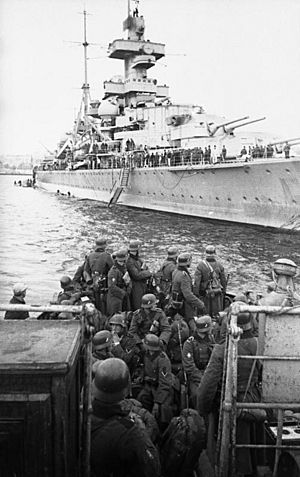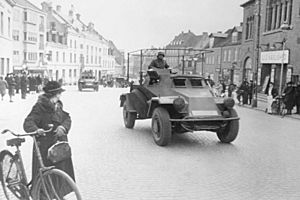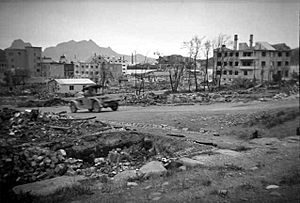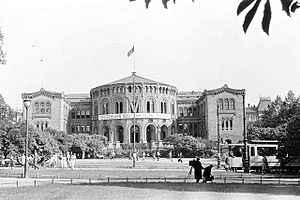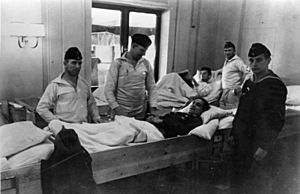Norwegian campaign facts for kids
Quick facts for kids Norwegian campaign |
|||||||||
|---|---|---|---|---|---|---|---|---|---|
| Part of Operation Weserübung | |||||||||
 The Battle of Narvik was Norway's toughest fight in World War II; nearly 7,500 Norwegian soldiers fought alongside British, French, and Polish troops. Narvik was the first city taken by the Third Reich that the Allies managed to recapture. |
|||||||||
|
|||||||||
| Belligerents | |||||||||
| Commanders and leaders | |||||||||
(9–10 April) (From 10 April) |
|||||||||
| Strength | |||||||||
| 100,000 7 divisions 1 Fallschirmjäger battalion |
Norway: 52,000 6 divisions Allies: 38,000 Total: 90,000 |
||||||||
| Casualties and losses | |||||||||
| Official German figures: 5,296 (1,317 killed on land 2,375 lost at sea 1,604 wounded) Material losses: 1 heavy cruiser 2 light cruisers 10 destroyers 6 U-boats 2 torpedo boats 15 light naval units 21 transports/merchant ships 90–240 aircraft |
Total: 6,602 British: On land: 1,869 killed, wounded, injured & missing At sea: 2,500 lost 1 aircraft carrier 2 cruisers 7 destroyers 1 submarine 112 aircraft French and Polish: 533 killed, wounded & missing 2 destroyers 2 submarines Norwegian: 1,700 total, of whom 860 were killed 107 naval ships sunk or captured 70 merchant ships & transports sunk (combined Norwegian/Allied total) |
||||||||
| Civilian (Norwegian) casualties: 535 killed |
|||||||||
The Norwegian campaign (April 8 to June 10, 1940) was a military operation during World War II. It involved Allied forces trying to defend northern Norway and the Norwegian military resisting an invasion by Nazi Germany.
Germany's main goal was to capture the port of Narvik. This port was crucial for shipping iron ore from Sweden, which Germany needed for its steel production. This route was especially important in winter when the Baltic Sea was frozen. The campaign lasted 62 days, making Norway the country that resisted German invasion the longest, besides the Soviet Union.
The campaign ended with Germany occupying all of Norway. However, the Norwegian King Haakon VII and Crown Prince Olav escaped to the United Kingdom. Parts of the Norwegian military also escaped and continued fighting overseas.
Contents
Background to the Conflict
World War II Begins
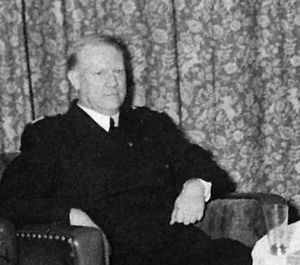
World War II began on September 1, 1939, when Germany invaded Poland. Britain and France, who had agreements with Poland, declared war on Germany two days later. For several months, there were no major battles. This period was called the "Phoney War."
Both sides wanted to open new battlefronts. The Allies, especially France, wanted to avoid the trench warfare seen in World War I. Norway, even though it was neutral, was very important to both sides.
Norway's government had prepared its army and navy to protect its neutrality. German U-boats (submarines) and aircraft from all warring countries soon violated Norwegian waters and airspace. Britain also pressured Norway to let them use Norwegian merchant ships. Norway agreed to charter many ships to Britain.
Why Norway Was Important
Norway was strategically important for several reasons. First, Germany relied on iron ore from Sweden. This ore was shipped through the Norwegian port of Narvik. This route was vital in winter when the Baltic Sea froze.
Controlling Norway would also help Germany in the Battle of the Atlantic. German ships and U-boats could use Norwegian ports to attack Allied convoys heading to Great Britain. German aircraft could also fly far into the North Atlantic from Norwegian air bases.
The Winter War and Allied Plans
When the Soviet Union attacked Finland on November 30, 1939, it started the Winter War. The Allies, along with Norway and Sweden, supported Finland. Norway secretly sent weapons to Finland and allowed Britain to send aircraft through its territory.
This war gave the Allies an idea: they could send troops to Finland and, while doing so, occupy Swedish iron ore fields and Norwegian ports. However, Norway and Sweden refused to allow Allied troops to cross their land. The Winter War ended on March 12, 1940, with the Moscow Peace Treaty. The Allied plans to send troops were then dropped.
Vidkun Quisling and German Interest
At first, Germany thought it was best for Norway to stay neutral. This would allow German merchant ships to safely transport ore through Norwegian waters.
However, German Admiral Erich Raeder pushed for an invasion. He believed Norwegian ports would be vital for Germany in a war against the United Kingdom. On December 14, 1939, Raeder introduced Adolf Hitler to Vidkun Quisling. Quisling was a pro-Nazi former Norwegian defense minister. He suggested cooperation between Nazi Germany and Norway.
After meeting Quisling, Hitler ordered his military leaders to plan an invasion of Norway. The first plan, Studie Nord, was ready by January 10, 1940. A new plan, Weserübung, began on February 5.
The Altmark Incident
On February 16, 1940, the British destroyer HMS Cossack entered Norwegian waters. It stopped and boarded the German ship Altmark in the Jøssingfjord. The Altmark was carrying 299 Allied prisoners of war.
Norwegian naval authorities had tried to inspect the Altmark earlier but were refused. When the British boarded the ship, the Norwegian vessels present did not intervene. The British freed the prisoners and killed seven Germans.
Germany protested strongly to Norway. Norway also protested to Britain. This incident made Germany speed up its invasion plans for Norway. On February 21, General Nikolaus von Falkenhorst was put in charge of the invasion. Hitler officially approved the invasion of Denmark and Norway on March 1.
Initial Plans for Invasion
Allied Plans for Norway
After the Winter War ended, the Allies decided that occupying Norway or Sweden might push these neutral countries to side with Germany. However, the new French Prime Minister, Paul Reynaud, wanted to take action against Germany. Winston Churchill also strongly pushed for action in Scandinavia. He wanted to cut off Germany from Swedish iron ore and make Scandinavian countries join the UK.
The Allies agreed on Churchill's plan, Operation Wilfred. This plan involved placing mines in Norwegian waters. The goal was to force German transport ships into international waters, where the Royal Navy could attack them. Along with this, Plan R 4 would be launched. If Germany reacted to Operation Wilfred, the Allies would then occupy Narvik, Trondheim, Bergen, and Stavanger.
German Invasion Plans
The German plan, Operation Weserübung, became urgent after the Altmark incident. The main goals were to secure the port of Narvik and control Norway to prevent it from helping the Allies. Germany would present the invasion as protecting Norway's neutrality.
Germany also decided to occupy Denmark. Denmark's location was important for controlling air and sea in the area. On April 2, Germany set April 9 as the invasion day (Wesertag).
The German plan for Norway involved capturing six main targets by sea landings: Oslo, Kristiansand, Egersund, Bergen, Trondheim, and Narvik. Paratroopers would also capture key airfields. The goal was to quickly overpower Norwegian defenders.
The German forces were organized into groups:
- Group 1: Ten destroyers with 2,000 mountain troops for Narvik.
- Group 2: The heavy cruiser Admiral Hipper and four destroyers for Trondheim.
- Group 3: Light cruisers Köln and Königsberg for Bergen.
- Group 4: Light cruiser Karlsruhe for Kristiansand.
- Group 5: Heavy cruisers Blücher and Lützow, light cruiser Emden for Oslo.
- Group 6: Four minesweepers for Egersund.
Two battleships, Scharnhorst and Gneisenau, would escort Groups 1 and 2.
For Denmark, motorized brigades and paratroopers would capture bridges and airfields. German heavy fighters would destroy Danish aircraft on the ground. German troops were told to fire only if fired upon.
Opposing Forces
German Forces
Germany used about 120,000 troops for the campaign. This included seven divisions and one paratrooper battalion. Most of the German navy's main ships were also used. The German air force (Luftwaffe) sent 1,000 aircraft, including 500 transport planes and 186 bombers.
Norwegian and Allied Forces
The Norwegian Armed Forces had about 55,000 soldiers involved in the fighting. The Allied expeditionary force had about 38,000 troops from Britain, France, and Poland.
German Invasion Begins
Fleet Movements
The German invasion started on April 3, 1940, with supply ships moving out. The Allies began their plans on April 4. British submarines were sent to the Skagerrak and Kattegat straits to watch for German ships.
On April 7, bad weather with thick fog and rough seas made travel difficult. This weather helped the Germans, hiding their ships. Early on April 7, German Groups 1 and 2, which had the longest distance to travel, set out.
British planes spotted the German ships, but the bad weather made it hard to track them. The British Admiralty thought the Germans were trying to break their blockade and attack Atlantic trade routes. Admiral Charles Forbes, commander of the British Home Fleet, set out to stop them.
The first direct contact between the two sides happened on April 8. The British destroyer Glowworm accidentally met German destroyers and the cruiser Admiral Hipper. Admiral Hipper badly damaged Glowworm, but Glowworm bravely rammed Admiral Hipper before sinking.
Also on April 8, the Polish submarine Orzeł sank a German troop transport ship, Rio de Janeiro, off southern Norway. Uniformed German soldiers and military supplies were found in the wreckage. Survivors said they were going to protect Bergen from the Allies. This information reached Oslo, but the Norwegian Parliament was focused on British mining operations and did not act quickly.
That night, German Group 5 met the Norwegian patrol vessel Pol III at the entrance to the Oslofjord. Pol III sent an alarm and fired on a German torpedo boat before being set on fire. Group 5 continued into the Oslofjord.
This activity alerted Oslo. The Norwegian cabinet met at midnight and ordered a partial mobilization of the army. However, due to poor communication, the mobilization was delayed.
Further north, the British battleship Renown encountered the German battleships Scharnhorst and Gneisenau. In a short battle, Renown hit the German ships, forcing them to flee north.
Weserzeit: Landings in Norway
In the Ofotfjord leading to Narvik, ten German destroyers arrived unopposed. They quickly captured the outer defenses. Inside Narvik harbor, two old Norwegian coastal defense ships, Eidsvold and Norge, tried to resist. They were quickly sunk by German torpedoes. The commander of Narvik then surrendered the town without a fight.
At Trondheim, German Group 2 faced little resistance. Admiral Hipper attacked the defenses, and its destroyers sped past. Only one destroyer was hit.

At Bergen, the defenses put up a stronger fight. The light cruiser Königsberg was seriously damaged. However, the Germans were able to land troops and capture the town after Luftwaffe planes arrived.
The defenses at Kristiansand fought even harder, pushing back the Germans twice and damaging the cruiser Karlsruhe. Confusion arose when Norwegians were told not to fire on British ships, and Germans used captured Norwegian codes. The Germans quickly took the harbor and the town.
The torpedo boat Greif captured Arendal without resistance. Its main goal was the undersea telegraph cable to the United Kingdom.
German Group 5 faced the most serious resistance in the Oslofjord. The cruiser Blücher, leading the group, was hit by every shell from Oscarsborg Fortress. Within minutes, Blücher was crippled and sinking. It was then sunk by old torpedoes fired from land. This ship carried many important German officers and plans for the occupation of Oslo.
The sinking of Blücher delayed the main German invasion force for Oslo by over 24 hours. This delay allowed the Norwegian royal family, Parliament, and the national treasury to escape the capital. Oslo was later captured by German troops flown into Fornebu Airport near the city.
Fornebu Airport was not heavily defended and was quickly captured. Norwegian fighter planes resisted until they ran out of ammunition. Oslo was declared an "open city" and soon surrendered.
At Egersund and Stavanger, German forces faced no significant opposition and quickly captured their targets.
Battle of Midtskogen
This small battle saved the Norwegian Royal Family. As the invasion began, the Norwegian government fled to Hamar. A group of Norwegian Royal Guardsmen and soldiers took positions at Midtskogen. Their goal was to stop or slow down the Germans, allowing the Royal Family to escape.
On April 10, a firefight ended with both sides retreating. The German leader, Captain Spiller, was hit. This battle bought precious time for the King and government.
Conquest of Denmark
Germany's invasion of Norway relied heavily on air power. To control the Skagerrak strait between Norway and Denmark, air bases in Denmark had to be seized. This would stop the Royal Navy from interfering with German supply lines. Capturing Aalborg Airport was especially important.
German forces crossed the Danish border and landed in Copenhagen on April 9. German paratroopers also captured Aalborg Airport. The Danish army was small and not well-equipped, but it resisted in some areas. However, German bombers threatened to bomb Copenhagen. King Christian X decided to surrender to avoid more Danish lives being lost. Denmark surrendered by 8:43 AM.
Many Danish merchant ships escaped the occupation. Their owner, Arnold Peter Møller, told his ships at sea to go to Allied or neutral ports. British forces also occupied the Faroe Islands to prevent Germany from taking them.
Norwegian Resistance and Government Flight
The German invasions mostly achieved their goal of surprise attacks. This was made easier by the Norwegian government's order for only a partial mobilization. However, the delay caused by the sinking of the Blücher in the Oslofjord gave Norwegians a few extra hours. They used this time to evacuate the Royal family and government to Hamar.
With the government on the run, Vidkun Quisling announced a coup on the radio, declaring himself the new Prime Minister. Quisling's government lasted until April 15.
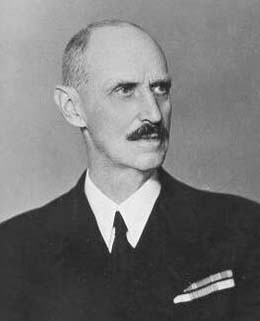
On the evening of April 9, the Norwegian government moved to Elverum, thinking Hamar was unsafe. They rejected all German demands. The Elverum Authorization was passed, giving the cabinet broad powers to make decisions. As a precaution, Colonel Otto Ruge set up a roadblock at Midtskogen. A small German force tried to capture King Haakon VII but was turned back after their leader was wounded.
On April 10, final talks between Norway and Germany failed. King Haakon VII refused to recognize Quisling's new government. The same day, panic spread in German-occupied Oslo due to rumors of British bombers. Many people fled the city.
On April 11, German bombers attacked Elverum, destroying the town center and killing 41 people. Bombers also attacked Nybergsund, trying to kill the King and Crown Prince Olav.
On April 10, Otto Ruge was promoted to major general and became Commanding General of the Norwegian Army. He replaced General Kristian Laake, who was criticized for being too passive. Ruge decided to delay the Germans until Allied help arrived.
On April 11, General Falkenhorst began his offensive from Oslo. His goal was to connect Germany's scattered forces before Norway could fully mobilize or the Allies could intervene.
Ground Campaign in Norway
When Britain realized the scale of the German invasion, they prepared a counter-attack. There was disagreement among British leaders. The army wanted to attack Trondheim in Central Norway, but Churchill wanted to reclaim Narvik. They decided to send troops to both locations. Admiral Lord Cork was in charge of Allied operations.
Fighting in Eastern Norway
After Ruge became commander, Norway's strategy was to slow down the Germans advancing north from Oslo. The main goal was to buy time for the Allies to recapture Trondheim. Norwegian units, many improvised, fought against the Germans.
The German advance from Oslo began on April 14, moving north towards the Gudbrandsdalen and Østerdalen valleys. The Germans met strong Norwegian resistance, especially at Haugsbygd, where fighting was intense. The Germans only broke through after using tanks, which the Norwegians lacked weapons to fight.
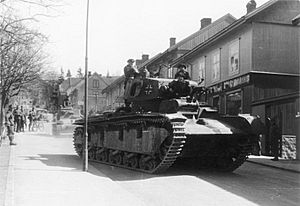
The Norwegian strategy began to fail when 3,000 troops in Østfold evacuated to Sweden without orders. Other Norwegian units also surrendered. When Allied plans to recapture Trondheim were canceled on April 20, Ruge's strategy became impossible.
British forces landed at Åndalsnes and moved into eastern Norway. They fought the Germans in several battles, including at Tretten, Fåvang, and Kvam. The British managed to delay the German advance for two days at the Battle for Kvam.
German air strikes were very effective against Norwegian resistance. German Junkers Ju 87 dive bombers especially lowered morale. Norwegian forces had almost no anti-aircraft weapons. British fighter planes tried to challenge German air power but were largely destroyed by German bombing.
Norwegian Collapse in Southern Norway
After capturing Kristiansand on April 9, the German forces in southern Norway secured the surrounding areas. After days of confusion, the 2,000 men of the defending 3rd Division in Setesdal surrendered on April 15 without fighting.
Campaign in Western Norway
The important western cities of Bergen and Stavanger were captured by Germany on April 9. The Norwegian forces in Bergen retreated east. The 4th Division, responsible for western Norway, mobilized around Voss. It was the only division outside northern Norway to mobilize fully. They managed to push back the initial German advance.
However, many of the 4th Division's forces were sent to reinforce the main front in eastern Norway. The remaining forces focused on preventing German advances from Bergen. After the Luftwaffe heavily bombed Voss on April 23–25, the Germans captured the town on April 26.
With no Allied or Norwegian help coming, the remaining Norwegian forces in western Norway were ordered to disband on May 1. Most ships of the Royal Norwegian Navy in western Norway were unable to escape to the United Kingdom or northern Norway.
Fighting in Central Norway
Allied plans for Central Norway involved a three-pronged attack on Trondheim. This plan was changed to only use northern and southern forces, as a direct assault on Trondheim was too risky.
To block Allied landings, German paratroopers dropped at Dombås on April 14. They blocked the rail and road network for five days before surrendering to the Norwegian Army on April 19.
A British advance force arrived at Åndalsnes on April 12. The main British landing happened on April 17.
British forces also landed at Namsos on April 14. They faced problems with misplaced supplies and a lack of air support. The Luftwaffe took full advantage of this. On April 20, German aircraft bombed Namsos, destroying most of the town.
British and French troops moved inland but constant air attacks prevented any offensive. On April 21, German forces attacked, forcing the Allies to retreat from Steinkjer. Steinkjer was heavily bombed by the Luftwaffe, leaving much of it in ruins.
End of Campaign in Central and South Norway

By April 28, the Allied leaders decided to withdraw all British and French forces from southern and central Norway. Norwegian forces covered the retreat and were then disbanded to avoid capture. On April 30, the German forces from Oslo and Trondheim linked up.
The port towns of Kristiansund and Molde (the Norwegian government's headquarters) were heavily bombed by the Luftwaffe.
British forces managed to escape from Åndalsnes by May 2, just hours before the Germans captured the port. Åndalsnes had been heavily bombed and was mostly in ruins. French and British forces were evacuated from Namsos on May 2, though two rescue ships were sunk by German dive bombers.
Organized Norwegian military resistance in central and southern Norway ended on May 5. The failure of this campaign led to the resignation of British Prime Minister Neville Chamberlain and the appointment of Winston Churchill.
King Haakon VII and his government arrived in Tromsø in northern Norway by May 1. Tromsø became the temporary capital of Norway.
Campaign in Northern Norway
In northern Norway, the Norwegian 6th division, led by General Carl Gustav Fleischer, faced the German invasion forces at Narvik. Fleischer became commander-in-chief of all Norwegian forces in northern Norway.
Allied forces were sent to northern Norway to recapture Narvik. However, the Allied command was not unified. The naval commander, Lord Cork, wanted an immediate assault on Narvik. The ground forces commander, Major-General Pierse Mackesy, wanted to avoid heavy casualties and damaging towns. They eventually agreed to Mackesy's plan.
The main Allied force began landing at Harstad on April 14. German air attacks on Harstad began on April 16, but anti-aircraft defenses prevented serious damage until later raids.
On April 15, the Royal Navy sank the German U-boat U-49. Documents found on the U-boat gave the Allies important information about German submarine operations.

After the Allied failure in Central Norway, more support was given to the northern forces. Air cover was provided by two squadrons of British fighter planes (Gloster Gladiators and Hawker Hurricanes) operating from Bardufoss Air Station.
As part of the Allied counter-offensive, French forces landed at Bjerkvik on May 13. Naval gunfire destroyed most of the village before the Germans were pushed out.
While Allied and Norwegian forces advanced at Narvik, German forces moved north through Nordland to help their trapped troops. They expanded Værnes Air Station near Trondheim to support their operations in the Narvik area.
British forces tried to stop the German advance further north at Bodø, Mo i Rana, and Mosjøen. They fought some skirmishes but were eventually forced to retreat to Bodø.
On May 27, Bodø was heavily bombed by the Luftwaffe. The bombing destroyed the airstrip, radio station, and most of the town's buildings, killing 15 people and leaving 5,000 homeless.
British forces were evacuated from Bodø from May 30 to June 2. The damaged airstrip fell into German hands, giving them an air base closer to Narvik.
On May 28, two French and one Norwegian battalion attacked and recaptured Narvik from the Germans. Polish troops advanced east, and other Norwegian troops pushed the Germans towards the Swedish border.
However, the German invasion of France and the Low Countries had changed the war. The importance of Norway lessened. On May 25, Allied commanders received orders to evacuate from Norway. The attack on Narvik was partly to hide their intention to leave. Shortly after Narvik was recaptured, the city was bombed and heavily damaged by the Luftwaffe.
Allied Withdrawal and Norwegian Surrender
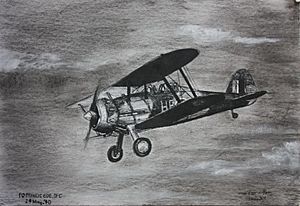
The general Allied retreat from Norway, called Operation Alphabet, was approved on May 24. Winston Churchill later said the decision was a mistake. The Norwegian authorities were only told on June 1.
On June 7, King Haakon VII, Crown Prince Olav, and the Norwegian cabinet decided to continue the fight from abroad. They left Norway on the British cruiser Devonshire and went into exile in the United Kingdom. Without Allied supplies, the Norwegian Army could not continue fighting.
By June 8, all Allied troops had been evacuated after destroying rail lines and port facilities. Germany launched Operation Juno to help their Narvik forces. When they discovered the evacuation, they attacked and sank two British destroyers and the aircraft carrier Glorious.
The Norwegian forces on the mainland surrendered to the Germans on June 10, 1940. Fighting stopped at midnight on June 9. The formal surrender agreement was signed in Trondheim. The 62-day campaign made Norway the country that resisted a German invasion for the longest time, besides the Soviet Union.
German Occupation of Norway
After Norway's army surrendered, Germany began its occupation. Although the regular Norwegian forces laid down their arms, a strong resistance movement grew. This movement became more effective over time.
The resistance began in late 1940, growing stronger and more organized. Even though the Gestapo (German secret police) tried to destroy early resistance groups, the movement survived. By the end of the war, the main resistance group, Milorg, had about 40,000 fighters.
Germany set up the Reichskommissariat Norwegen to govern Norway, led by Josef Terboven. The Germans tried to make the exiled Norwegian government irrelevant, especially targeting the King. Weeks after the campaign, Germans pressured the Norwegian parliament to ask King Haakon VII to give up his throne. On July 3, King Haakon VII refused. His refusal, known as "The King's No," encouraged resistance.
The Royal Norwegian Navy and Royal Norwegian Air Force (RNoAF) were rebuilt in Britain. They used remaining forces from the Norwegian Campaign and new recruits who escaped Norway. They received new ships and aircraft from Britain and America. By the end of the war, the Royal Norwegian Navy had grown to 58 warships.
Norwegian squadrons flew with the British RAF Fighter and Coastal Commands. They flew fighter planes like Hawker Hurricanes and Supermarine Spitfires, and patrol bombers. By November 1944, the Norwegian air services combined to form the RNoAF.
A Norwegian Army of about 4,000 soldiers was also rebuilt in Scotland. Except for special forces, it saw little action. Some Norwegian troops helped liberate Finnmark in northern Norway in 1944–45.
In neutral Sweden, a "police troops" force was secretly built up. By the end of the war, this force had about 13,000 well-trained soldiers. In 1945, about 1,300 of these "police troops" helped liberate Finnmark.
Casualties and Losses
German Losses
Official German casualties for the Norwegian Campaign were 5,296. Of these, 1,317 were killed on land, 2,375 were lost at sea, and 1,604 were wounded.
German losses at sea were heavy. They lost one heavy cruiser, two light cruisers, 10 destroyers, and six U-boats. Many other ships were badly damaged. After the campaign, only three cruisers and four destroyers were still working.
Official German sources say 90 German aircraft were lost. Some historians estimate as many as 240. Germany also lost 21 transport and merchant ships.
Norwegian and Allied Losses
Total Norwegian and Allied casualties were about 6,602. The British lost 1,869 killed, wounded, and missing on land, and about 2,500 at sea. French and Polish forces lost 533 killed, wounded, and missing.
Norway had about 1,700 casualties, with 860 killed. About 400 Norwegian civilians were also killed, mostly by German bombing.
The Royal Norwegian Navy, with 121 ships, was almost completely destroyed. Only 15 warships and about 600 men escaped to the United Kingdom. The rest were sunk, scuttled (sunk by their own crews), or captured.
The British lost one aircraft carrier, two cruisers, seven destroyers, and a submarine. However, their much larger fleet could handle these losses better than Germany.
The French Navy lost a destroyer and a submarine. The Polish Navy lost a destroyer and a submarine.
The British lost 112 aircraft. Norway lost all its aircraft except a few that escaped to the UK or neutral Finland.
The Allies and Norwegians combined lost about 70 merchant ships and transports.
In Fiction
- The 1942 film They Raid by Night takes place in Norway just after the campaign.
- The 1942 film The Day Will Dawn is mostly set in Norway before and after the invasion.
- The John Steinbeck novel The Moon Is Down depicts the invasion and occupation, though it doesn't name Germany or Norway.
- Paul Milner, a character in the TV show Foyle's War, served in the Norwegian Campaign and was injured there.
- The adventure novel Biggles Defies the Swastika by W. E. Johns shows Squadron Leader Bigglesworth's adventures trying to escape Norway during the German invasion.
- The 1993 Norwegian film The Last Lieutenant is set around the Norwegian Campaign and is based on a real reservist officer.
- Into the White (2011) is a Norwegian film about German and British airmen who meet after their planes crash in the Norwegian mountains.
- The 2008 novel The Odin Mission by James Holland is about British, French, and Norwegian troops trying to reach Allied lines while protecting a civilian with important information.
- The 2016 Norwegian film The King's Choice is based on the true story of King Haakon VII facing an ultimatum from the Germans in April 1940.
- In the 2018 video game Battlefield V, the Norwegian Campaign is featured in multiplayer, with maps based on the Battle of Narvik and Norwegian mountains.
See also
 In Spanish: Campaña de Noruega para niños
In Spanish: Campaña de Noruega para niños
- List of Norwegian military equipment of World War II
- List of German military equipment of World War II
- List of British military equipment of World War II
- List of French military equipment of World War II (also used by Polish troops in Norway)
Images for kids




